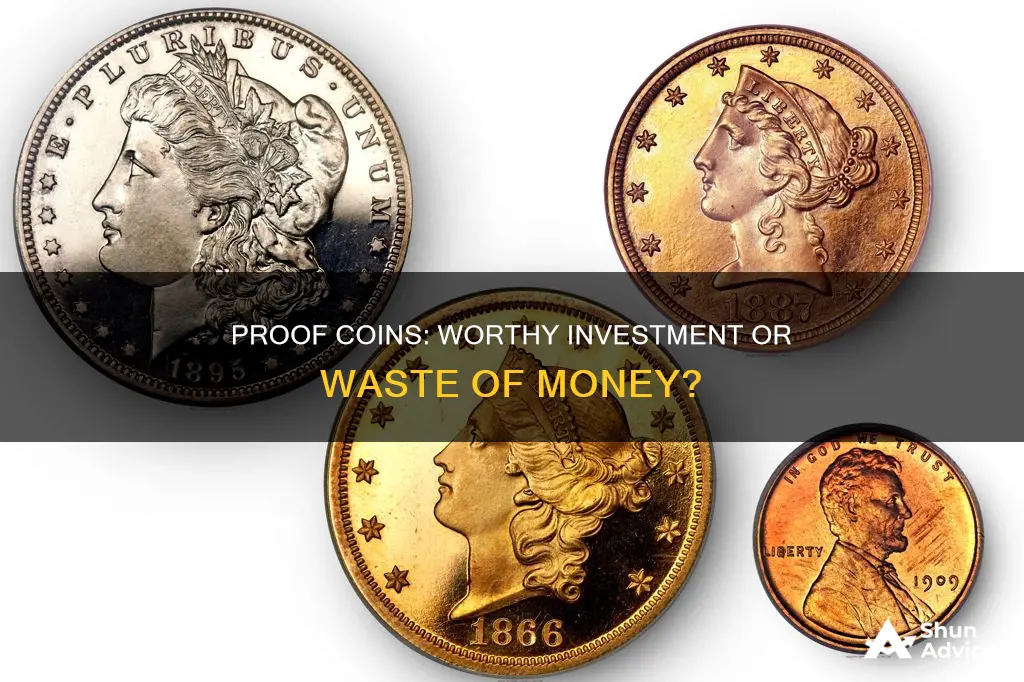
Proof coins are a unique type of coin that undergoes a special treatment and finishing process to ensure the best strike possible. They are struck twice, resulting in a more defined, intricate, and shinier appearance than regular coins. While proof coins are similar to bullion coins, they differ in that they are produced in smaller mintages, have a higher degree of scarcity, and are often sold at a premium. So, are proof coins a good investment?
Proof coins offer several benefits that make them an attractive investment option. They are almost always rare, with limited mintage, making them highly sought-after by collectors. They also have high numismatic value due to their exceptional beauty and quality. Additionally, they serve as a hedge against inflation and are considered a tangible asset. However, there are also some risks and challenges associated with investing in proof coins, including market volatility, counterfeiting, liquidity issues, and high initial premiums. Ultimately, whether proof coins are a good investment depends on individual investment goals and strategies.
| Characteristics | Values |
|---|---|
| High quality finish | Proof coins have a high-quality finish due to a specialised minting process that includes hand polishing, chemical treatments, and striking the coin at least twice. |
| Rarity | Proof coins are often released in limited editions, making them rarer than non-proof coins. |
| Collectability | Proof coins are highly collectable due to their visual appeal and limited availability. |
| Numismatic value | Proof coins have higher numismatic value than regular bullion coins because of their rarity and exceptional designs. |
| Historical significance | Proofs of historically popular or significant coins can be sold at inflated premiums. |
| Hedge against inflation | As physical precious metal products, proof coins can retain their value during inflationary periods when the value of stocks, bonds, and real estate may decline. |
| Profit potential | Proof coins have seen substantial gains over the long run, and their scarcity can lead to greater profit potential. |
| Diversification | Proof coins can help diversify a portfolio by offering both numismatic value and precious metal content. |
| Higher cost | Proof coins typically cost more than non-proof coins due to the specialised minting process and limited availability. |
| Counterfeiting risk | The high value of proof coins makes them a target for counterfeiting, although buying from reputable dealers can mitigate this risk. |
What You'll Learn

Proof coins are rare and have limited mintage
Proof coins are deliberately released in limited quantities by manufacturers such as the United States Mint, which increases their rarity and value. For example, in 1998, the US Mint struck 1.5 million bullion American Gold Eagle coins, but only 26,000 Proof Gold Eagles—that's a ratio of approximately 57 bullion coins for every proof coin.
The scarcity of proof coins also impacts their profit potential. While bullion coins' value is tied exclusively to the weight of their precious metal content, proof coins are prized for their scarcity, granting them additional insulation from spot price variations and greater profit potential.
Proof coins are also visually striking, which adds to their appeal. They undergo a specialised minting process that includes hand polishing, chemical treatments, and multiple strikes, resulting in a higher definition and luster. This exceptional quality and presentation make them highly collectible.
The high numismatic value of proof coins is further enhanced by their beautiful designs and exceptional rarity. They are often sold at inflated premiums due to their historical significance, making them a great way to diversify one's portfolio.
In summary, the limited mintage of proof coins, combined with their high quality, rarity, and visual appeal, makes them a sound investment option, particularly for collectors who appreciate their numismatic value.
Junk Silver Coins: Smart Investment or Not?
You may want to see also

They have higher numismatic value
Proof coins are struck using highly polished blanks and dies, resulting in a detailed, lustrous finish. They are produced in limited quantities, adding to their rarity and making them desirable to collectors. They are also often made from precious metals like gold or silver, which tend to rise in value over time.
Proof coins are graded on a scale, usually from 1 to 70, with 70 representing a perfect coin. This grading offers assurance to investors about the coin's condition and value, allowing them to compare coins and make informed decisions. The higher the grade of a proof coin, the more valuable it becomes.
The value of proof coins is influenced by several factors, including rarity, condition, historical significance, and demand. Rarity plays a crucial role in their value, as limited availability can increase demand and push market prices upwards. For example, the 1895 Morgan Dollar Proof Set, with a mintage of 880, sold for $1,150,000 in 2023.
The condition of proof coins is another significant factor in their value. Collectors value coins that are well-preserved and have minimal scratches, spots, or imperfections. Grading services assess the condition of coins using a numerical scale, and higher grades signify better preservation, leading to higher prices.
Historical significance also adds value to proof coins. Proof sets that mark important moments in history, such as the introduction of a new coin design or an anniversary, are often valued higher due to their commemorative nature.
Lastly, the demand for a particular proof set among collectors can impact its market value. Sets that are highly sought-after due to their rarity or aesthetic appeal tend to fetch higher prices.
In summary, proof coins have higher numismatic value due to their limited mintage, exceptional quality, and the collectability associated with their historical significance and precious metal content. Their value is further enhanced by factors such as rarity, condition, historical significance, and market demand.
Small Bitcoin Investments: Worth the Risk?
You may want to see also

They are a good hedge against inflation
Proof coins are a good hedge against inflation. All precious metal products function as a hedge against inflation. Gold, silver, and platinum are considered non-correlated assets, meaning their value is not influenced by the performance of the traditional stock market or the economy in general. When inflation is high and faith in fiat currency is low, precious metals like gold and silver often perform better than traditional asset classes.
Proof coins, in particular, are an especially effective tool for hedging against inflation due to their high numismatic and collectible value. As inflation negatively impacts the value of stocks, bonds, and real estate, the collectability and precious metal content of proof coins can help them retain their investment value over time.
The high numismatic value of proof coins is due in part to their limited mintage. Coin manufacturers like the United States Mint deliberately release only a certain number of proof-quality coins each year, making them rarer than non-proof coins. This limited availability can lead to an increase in numismatic value over time, as collectors seek out these rarer coins.
Additionally, proof coins undergo a specialized minting process that results in a higher quality product. Proof coins are hand-polished and chemically treated before being struck multiple times, resulting in a higher definition and luster. This extra level of artistry contributes to their value and makes them highly sought-after by collectors.
The combination of their limited mintage, specialized minting process, and high numismatic and collectible value makes proof coins a good hedge against inflation and a worthwhile investment option.
Piedfort Coins: Smart Investment or Risky Gamble?
You may want to see also

They are a tangible asset
Proof coins are a good investment because they are a tangible asset. Unlike stocks and bonds, which are held by financial institutions, proof coins are physical precious metal products that you can hold and maintain yourself. This means that you have more control over your investment and can secure your financial future.
Proof coins are also a good investment because they are a hedge against inflation. As inflation negatively impacts the value of stocks, bonds, and real estate, the collectability and precious metal content of proof coins can help them retain their value over time.
The high numismatic and collectible value of proof coins makes them a particularly effective tool for hedging against inflation. The relative scarcity of proof coins, due to their limited mintage, also contributes to their value.
Additionally, proof coins have a high-quality finish and attractive appearance, making them popular among collectors. The specialised minting process, which includes hand polishing and chemical treatments, creates a high level of detail and luster. This exceptional quality and presentation further increase the collectability and value of proof coins.
Overall, the tangible nature of proof coins, combined with their other advantages, makes them an ideal way to invest in gold, silver, or platinum.
Coinbase Cryptocurrency Investing: A Beginner's Guide
You may want to see also

They are visually striking
Proof coins are visually striking. Their manufacturing process, which includes hand polishing, chemical treatments, cleaning, and multiple strikes, results in a high-quality finish with a polished look and feel, and sharp edges and design. The polished areas of the coin, especially in silver coins, take on a mirror-like finish. The dies used for production are often chemically treated to create a frosty appearance in some areas of the coin. This extra level of artistry makes proof coins exceptional and highly sought after by collectors.
Proof coins' visual appeal is one of the primary reasons for their popularity. They are often purchased as gifts, presents, and keepsakes, and their high quality makes them one of the most in-demand collectibles in the market. Their attractiveness and appeal also make them ideal for special occasions, such as birthdays or commemorating events, or for building an annual collection.
Proof coins' visual appeal also adds to their value. They are worth more than regular strikes on the market, with proof coins often costing more than double their non-proof counterparts. This is due to their relative scarcity, as they are produced in smaller mintages than their bullion counterparts, and their demand among collectors.
The visual appeal of proof coins also contributes to their historical significance. Proofs of historically popular or significant coins are often sold at inflated premiums, making them a great way to invest and diversify one's portfolio. Their exceptional beauty and quality make them a good investment option, offering a sound mixture of investment and collectability.
Square's Bitcoin Investment: A Bold Move
You may want to see also
Frequently asked questions
Proof coins are coins that undergo a special treatment and finishing process to ensure the best strike possible. They are often hand-polished and struck multiple times to create a high-quality finish with sharp edges and a mirror-like background.
Proof coins can be a good investment, especially for collectors. They are rarer than non-proof coins, have a high numismatic value, and are in high demand due to their exceptional quality and beauty. However, they have higher premiums than bullion coins, which may impact their liquidity.
In addition to their potential for numismatic appreciation, proof coins offer a hedge against inflation as their value is not influenced by the traditional stock market or the general economy. They are also a tangible asset, allowing investors to physically hold and maintain their investment.







